Cultural Travel in Tana Toraja, Sulawesi, Indonesia
Article and photos by Lies Ouwerkerk
Senior Contributing Editor
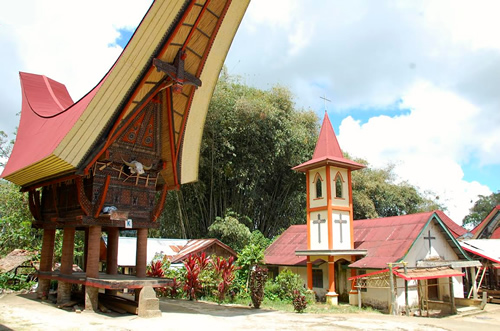
|
|
A traditional tongkonan next to a Christian church in Sulawesi, Indonesia.
|
First-time travelers to Toraja land (Tana Toraja), eager to learn about the belief system, social customs, and ritual practices of the indigenous culture of this region, would do well to hire an experienced guide who is familiar with the complex expressions of Torajan spiritual and social life. Although it is definitely not difficult to find a guide in Rantepao — the cultural centre of Toraja land and a good base from where to explore the region — some caution should be exercised, as some “guides” have simply disappeared with pre-paid money before a tour even commenced. There have also been warnings on some travel forums regarding guides harassing solo female travelers.
I hired Yohanis on the recommendation of several travelers who had used his services, and whose reviews were unanimously positive:
-
Yohanis' English seemed good enough, judging by the prompt emails he sent in response to questions.
-
His suggestions were sound.
-
His daily fee was not exorbitant.
Yohanis' directions for traveling from Makassar’s Sultan Hasahuddin International Airport to Rantepao were clear: I had to take a taxi from the airport to the bus station in Makassar, and from there board a bus to Toraja land. Luck was with me, since the taxi had hardly left the airport and the driver spotted the Toraja bus coming from the opposite direction. He started to wave frantically to the bus driver, and a quick U-turn later, I was on my way to Tana Toraja in a somewhat rickety bus that would take 10 hours to reach Rantepao.
As a solo female traveler, I did not want to arrive late at night and risk ending up in some dodgy hotel, so I had booked a room on-line in one of the “better” and well-reviewed lodgings in Rantepao. I was met at Rantepao the next morning by Yohanis, a friendly Toraja guide in his early 40’s, to discuss the details of my week in Tana Toraja. I could choose renting a car with a driver or contenting myself with the passenger seat of his motorcycle. I opted for the latter, partly because the end of my Asia trip was near and funds had considerably slimmed down, partly because it simply seemed more adventurous. All Yohanis asked for this mode of transport was having the gas tank filled, which amounted to $15 for the whole week.
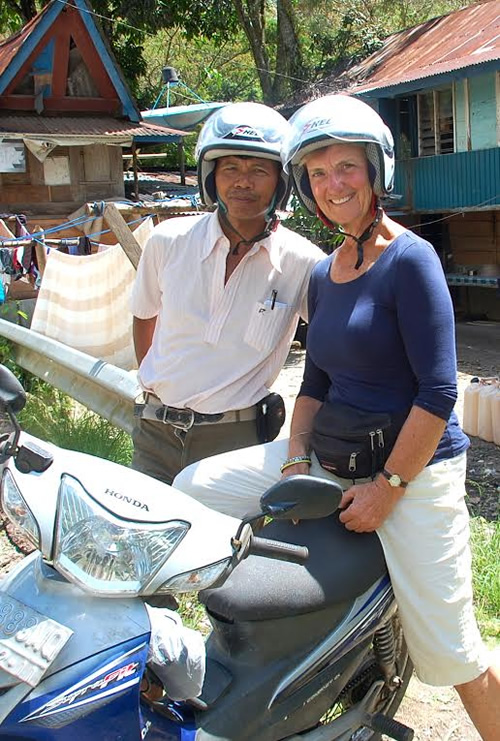
|
|
Wandering through Tana Toraja by motorcycle (Yohanis at left).
|
"Would You Like to Go to a Funeral?"
Since death plays such a central role in Torajan culture, I was not surprised when Yohanis suggested we go to a funeral first thing that morning. Being a Rantepao native, and well connected in his community, he knew where funerals were held that week and how to get there.
Equipped with some packs of cigarettes for the hosts, we slip-slided our way over muddy paths through the hilly countryside, and stopped in the middle of rice fields at a huge tongkonan, a traditional Torajan dwelling with a saddle-backed roof and painted decorative panels, surrounded by several smaller rice granaries built and decorated in the same manner.
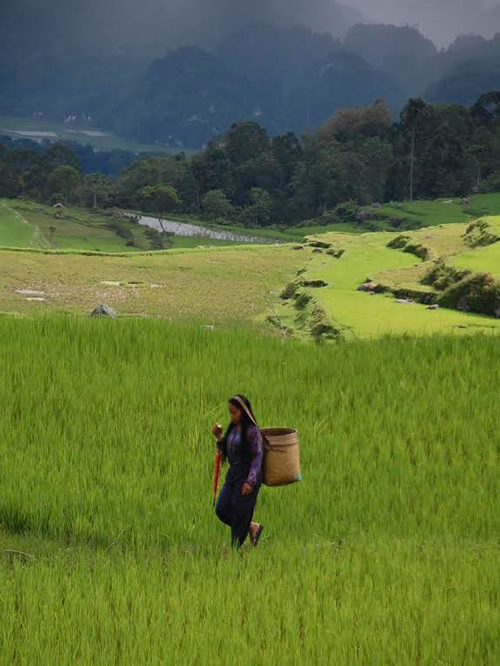
|
|
Terraced wet rice fields on Toraja's mountain slopes.
|
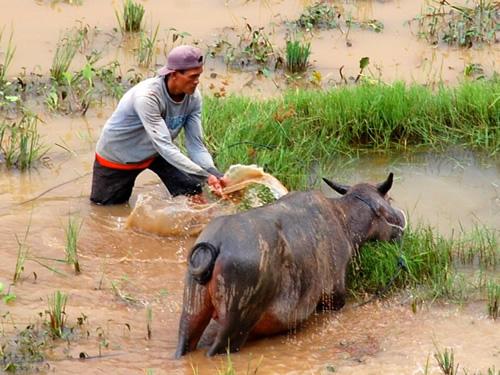
|
|
The water buffalo,Toraja's most important animal, lives in the rice fields.
|
The scene was surreal: hundreds of people in ceremonial attire were seated in huge temporary reception rooms constructed around the open grassy field between the tongkonan and the rice barns, watching a group of older women with long mortars pounding wooden rice vessels in a certain rhythm. Then men with machetes entered the scene and started slaughtering buffaloes by the dozens (to ensure eternal life in the afterlife and to safeguard the descendants, I was told), accompanied by loud applause and encouraging shouts from the audience.
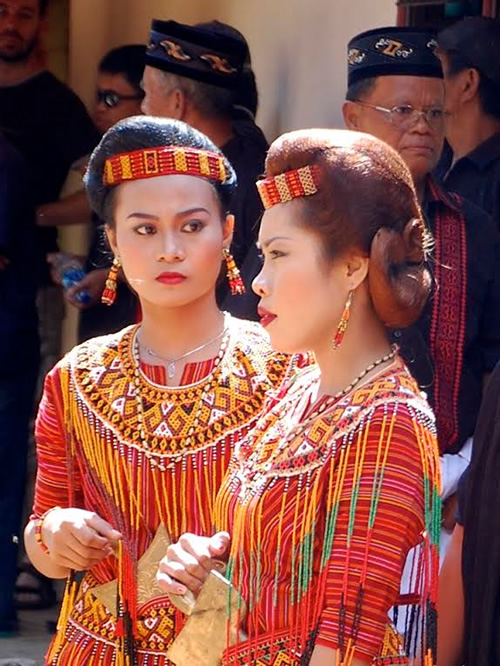
|
|
Women in ceremonial dress, the chief mourners, in charge of heading the funeral procession.
|
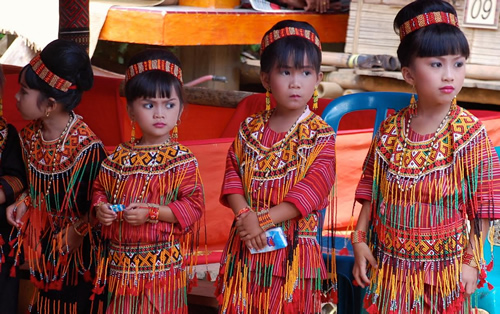
|
|
Young girls in traditional clothes at the entrance of the principal reception room.
|

|
|
Torajan boy in ceremonial attire.
|
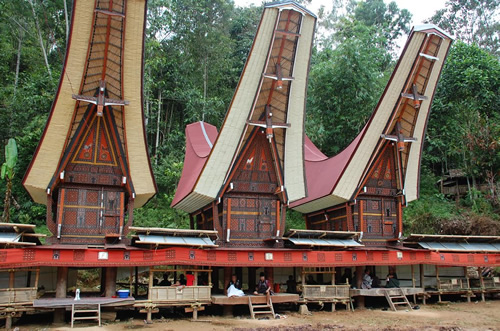
|
|
Tongkonans with make-shift rooms for guests at a funeral.
|
A karopi, a wooden coffin, in which the corpse of the deceased, injected with formaldehyde, had been kept for many days until all family members living in other parts of Indonesia had arrived at the ancestral home and all preparations for the funeral had been made, was placed on a bier, on the platform of one of the barns. As Yohanis explained, from there the corpse would preside over the joyful ceremonies of the days to come, celebrated with dancing, chanting, drinking, eating, and socializing. On the last day, the coffin would be carried to the final resting place, accompanied by the souls of slaughtered piebald buffaloes who would conduct the deceased’s spirit safely to Puya, the other world. Meanwhile, the slaughtered buffaloes’ flesh would be distributed amongst the living.
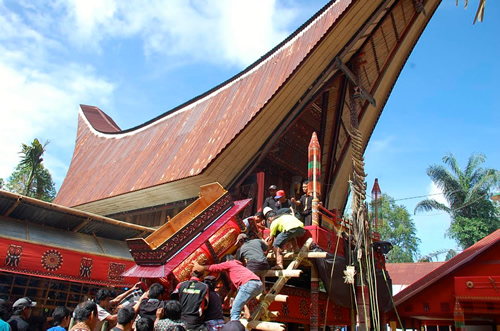
|
|
The coffin is carried to an upstairs room of a tongkonan before the corpse will be re-wrapped and interred.
|
We were warmly received by the eldest son of the deceased, who insisted we sit down in the principal reception booth to drink tea, eat cake, and chat with his family. The visit of a foreigner provides even more prestige to an already elaborate funeral ceremony.
Although the ranking system within Torajan society is less rigid these days than in the past, it is acutely present during funeral ceremonies, where seating areas are still divided into rooms for nobility and important guests on the one hand, and commoners on the other. Moreover, only high-class people can perform certain death rituals, and the length of a funeral as well as the number of animals slaughtered also varies according to social status: the longer the funeral lasts, and the more buffaloes and pigs are slaughtered, the wealthier the family of the deceased is in the community.
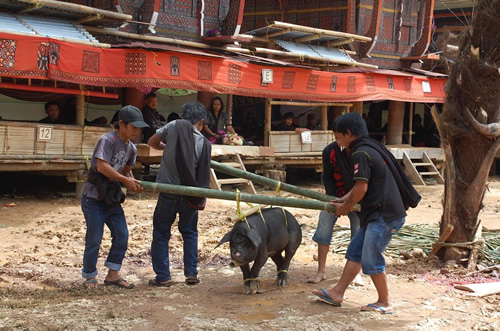
|
|
Sacrificing a pig during a funeral ceremony.
|
On our way back to town, we passed the workshop of a local woodcarver, who was putting the final touches to a tau tau, or wooden effigy, an integral part of the Torajan funeral ceremonies. The tau tau is a common sight in front of graves, where they still guard the fields and villages, despite the fact that many graves have been vandalized and looted by tomb raiders. Nowadays, a tau tau is more refined and has photographic likeness with the person it represents. Such a likeness is absent in the more primitive effigies such as the ancient wooden doll-like ones staring with wide eyes from the multiple balconies hewn in the rocks of Lemo village, which we visited afterwards.
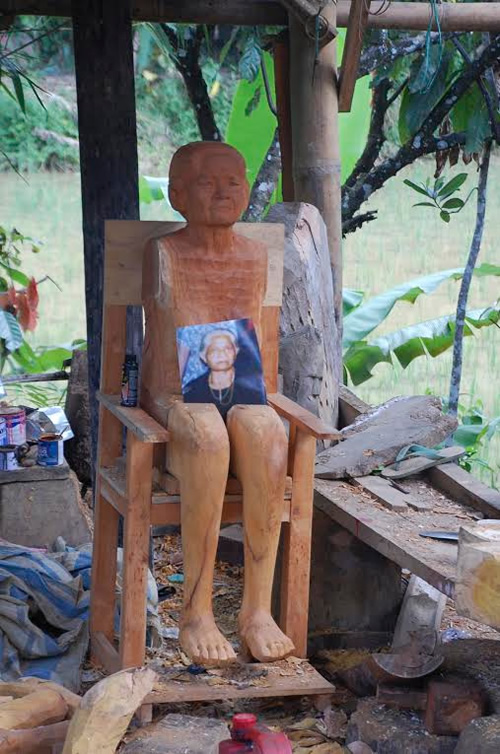
|
|
Effigy resembling the deceased.
|
"Pack for a Purpose"
Before heading for Sulawesi, I had stumbled upon the website of "Pack for a Purpose," a non-profit organization that encourages travelers to make a little space available in their luggage for items needed by local projects all over the world. One of the projects listed, the Yaysan Pak orphanage, happened to be located close to Rantepao. One day I headed — equipped with my care package full of grooming essentials and deflated soccer balls — for the village where the orphans lived with their caretakers. The ensuing meeting presented a wonderful opportunity to engage in a lively conversation with Torajan youngsters aged 8 - 16, who had all learned to converse in English.
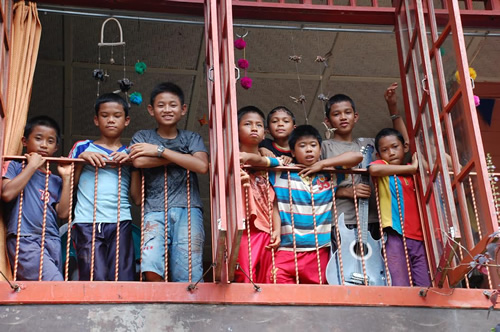
|
|
Bringing a care package through "Pack for a Purpose" to boys in an orphanage.
|
Hiking in Toraja Land
Before leaving for our 2-day trek through the highlands, Yohanis and I stocked up on food supplies from the market. Then we chartered a taxi driver with a 4WD, since we had to reach our point of departure over unpaved, steep, and rocky paths. Soon we were wandering through a landscape of rugged granite cliffs, dense pine forests, waterfalls, and mountain slopes with green rice terraces and coffee plantations, dotted with clusters of tongkonans. During our trek, Yohanis carried all the food and water, and had to help me more than once to manage the muddy descents and slippery rocks. Hiking effortlessly in his ordinary sneakers, he certainly put me shame, as I was constantly huffing and puffing to keep up with him!
The Tongkonan
To get a feel for daily life in the countryside, we spent the night in a traditional tongkonan along the way. Upon arriving at the family’s compound, we were greeted by the grandmother who lived in the central house that was flanked by a few other, smaller tongkonans inhabited by her daughters and their families. While we were enjoying tea and cookies, seated on a rattan mat rolled out on the platform of the rice barn, she quickly vacated her bedroom in the upstairs living quarters and unfolded two sleeping mats for us, topped with piles of blankets. Contrary to the huge upswept roof, the internal space of the house, accessed by a narrow ladder, was cramped and dark. A small outhouse was located in the backyard, which resulted in creating a bit of a "situation" later on that evening when a heavy downpour announced the beginning of the rainy season.
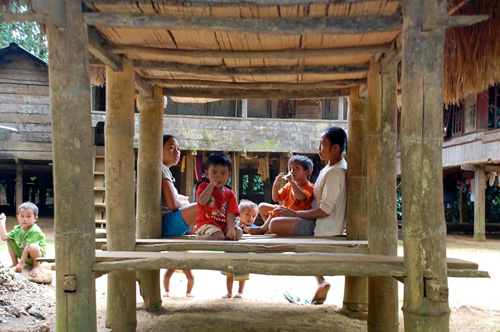
|
|
Platform of rice barn in the compound for communal seating.
|
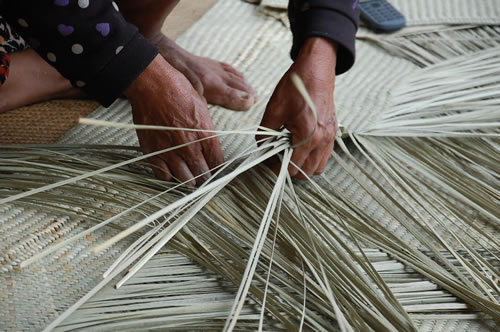
|
|
A rattan mat in the making.
|
Our stay provided an opportunity to examine the tongkonan from up close, with its numerous symbolic patterns painted on the exterior walls in the four primary Toraja colors of white, black, red, and yellow. The face of the tongkonan was oriented towards the northeast: the north being the direction of the life-giving waters of the Sa’dan River, and the east representing spirits of life and agricultural prosperity. Plants on the east side of the house marked where placentas had been buried, a Torajan custom to link children forever to their ancestral home. A carved water buffalo head, painted in white and black, adorned the front buttress post at the face of the house, together with a carved bird’s head. In Toraja culture, a buffalo symbolizes virility, power and wealth, and a bird elegance and femininity.

|
|
Decoration of tongkonan in Toraja colors: white, black, red, and yellow.
|
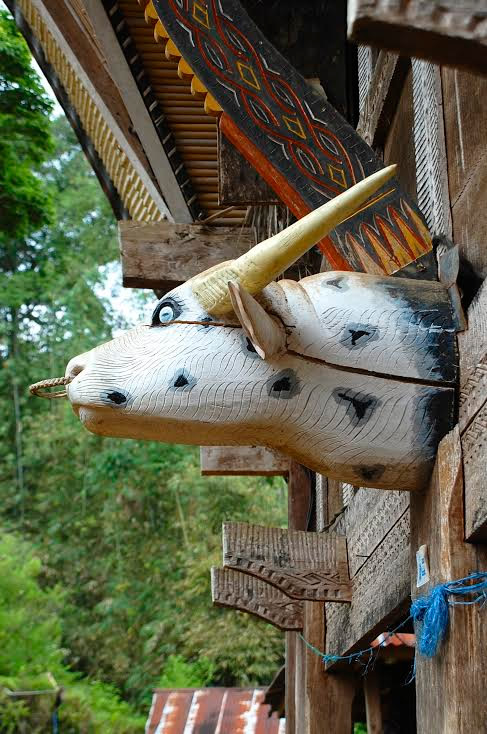
|
|
Carved head of a piebald male water buffalo.
|
In addition, numerous buffalo horns were posted at the face of the house, as well as pig jowls in front of the rice barn, all expressing achieved wealth and inherited status.
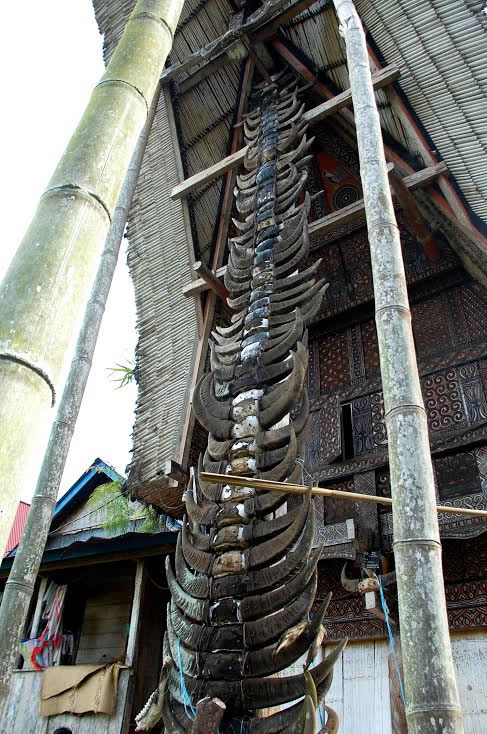
|
|
Horns of water buffaloes previously sacrificed, posted in front of a tongkonan.
|
Farewell
My stay in Toraja would certainly not have been so meaningful had I not hired a knowledgeable and well-connected guide who spoke English, Bahasa, as well as the Toraja language.
On departure day, Yohanis accompanied me to the bus station in Rantepao. He let the driver know where I had to get off in Makassar, checked if my seat was OK, and assured me once more that there would be a new tongkonan waiting for me when I would return to his hometown one day. He would build it himself on the grounds of his ancestors, with the help of family members, as soon as enough money had been accumulated to buy the materials. However, life in Tana Toraja, where people mainly live from subsistence farming and tourism, is not always easy and predictable. Yohanis’ emails between December and March reported an extremely wet season without many tourists. By April, however, with the year’s best travel weather at his doorstep, his hopes had clearly gone up again.
|
For More Info
Guide Yohanis at yuttu2003@yahoo.com, guide Otto at toraja_otto@yahoo.com, tour organizer Dodo the Penman at donow77@hotmail.com. Fees are generally around $50 per day. It is wise to ask on the forehand whether extra costs (food, overnight stay, transport, entrance fees, etc.) are included.
Pack for a Purpose
Several bus companies run morning and overnight buses between Toraja and Makassar. There have been warnings on forums re thieves operating on overnight buses while travelers were asleep. A one-way ticket costs about $10; a taxi will charge about $120. Buying a return ticket Toraja->Makassar at least one day in advance is recommended, as buses fill up quickly.
|
Lies Ouwerkerk is originally from Amsterdam, The Netherlands, and currently lives in Montreal, Canada. Previously a columnist for The Sherbrooke Record, she is presently a freelance writer and photographer for various travel magazines.
|
